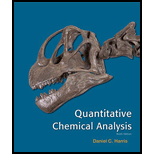
(a)
Interpretation:
The suitable chromatography technique should be given for purification of antibody.
Affinity Chromatography:
The sample mixture is passed through a column, only a single molecule is bounded to the stationary phase and other molecules are eluted out. After elution, the affinity of bonded molecules is realised, when pH of the column is varied. In the above chromatography affinity act as an important role, therefore it is called as affinity Chromatography.
(b)
Interpretation:
The suitable chromatography technique for desalting of protein should be given.
Molecular exclusion chromatography:
The molecules are separated by its size in chromatographic separation is known as molecular exclusion chromatography.
In this chromatography, the large molecules are eluted first then small molecules are separated.
The elution volume is directly proportional to the molar mass of the molecule so it is called as gel filtration or permeation chromatography.
Hydrophobic interaction chromatography:
The substance, which is repels the water is known as hydrophobic substance. In Hydrophobic interaction chromatography, the stationary phase is hydrophobic substance.
In the chromatography, the molecule is interact with stationary phase of the column and the solubility of molecule, which is going to separate is decreasing salt concentration of reagent ti increasing solubility molecule.
(c)
Interpretation:
The suitable chromatography technique for molar mass determination of polystyrene should be given.
Molecular exclusion chromatography:
The molecules are separated by its size in chromatographic separation is known as molecular exclusion chromatography.
In this chromatography, the large molecules are eluted first then small molecules are separated.
The elution volume is directly proportional to the molar mass of the molecule so it is called as gel filtration or permeation chromatography.
Hydrophobic interaction chromatography:
The substance, which is repels the water is known as hydrophobic substance. In Hydrophobic interaction chromatography, the stationary phase is hydrophobic substance.
In the chromatography, the molecule is interact with stationary phase of the column and the solubility of molecule, which is going to separate is decreasing salt concentration of reagent ti increasing solubility molecule.
(d)
Interpretation:
The suitable technique for separation of Cytochrome and Ribonuclease from its mixture should be given.
Molecular exclusion chromatography:
The molecules are separated by its size in chromatographic separation is known as molecular exclusion chromatography.
In this chromatography, the large molecules are eluted first then small molecules are separated.
The elution volume is directly proportional to the molar mass of the molecule so it is called as gel filtration or permeation chromatography.
Hydrophobic interaction chromatography:
The substance, which is repels the water is known as hydrophobic substance. In Hydrophobic interaction chromatography, the stationary phase is hydrophobic substance.
In the chromatography, the molecule is interact with stationary phase of the column and the solubility of molecule, which is going to separate is decreasing salt concentration of reagent ti increasing solubility molecule.
Affinity chromatography:
The sample mixture is passed through a column, only a single molecule is bounded to the stationary phase and other molecules are eluted out. After elution, the affinity of bonded molecules is realised, when pH of the column is varied. In the above chromatography affinity act as an important role, therefore it is called as affinity chromatography.
Want to see the full answer?
Check out a sample textbook solution
Chapter 26 Solutions
Quantitative Chemical Analysis
 ChemistryChemistryISBN:9781305957404Author:Steven S. Zumdahl, Susan A. Zumdahl, Donald J. DeCostePublisher:Cengage Learning
ChemistryChemistryISBN:9781305957404Author:Steven S. Zumdahl, Susan A. Zumdahl, Donald J. DeCostePublisher:Cengage Learning ChemistryChemistryISBN:9781259911156Author:Raymond Chang Dr., Jason Overby ProfessorPublisher:McGraw-Hill Education
ChemistryChemistryISBN:9781259911156Author:Raymond Chang Dr., Jason Overby ProfessorPublisher:McGraw-Hill Education Principles of Instrumental AnalysisChemistryISBN:9781305577213Author:Douglas A. Skoog, F. James Holler, Stanley R. CrouchPublisher:Cengage Learning
Principles of Instrumental AnalysisChemistryISBN:9781305577213Author:Douglas A. Skoog, F. James Holler, Stanley R. CrouchPublisher:Cengage Learning Organic ChemistryChemistryISBN:9780078021558Author:Janice Gorzynski Smith Dr.Publisher:McGraw-Hill Education
Organic ChemistryChemistryISBN:9780078021558Author:Janice Gorzynski Smith Dr.Publisher:McGraw-Hill Education Chemistry: Principles and ReactionsChemistryISBN:9781305079373Author:William L. Masterton, Cecile N. HurleyPublisher:Cengage Learning
Chemistry: Principles and ReactionsChemistryISBN:9781305079373Author:William L. Masterton, Cecile N. HurleyPublisher:Cengage Learning Elementary Principles of Chemical Processes, Bind...ChemistryISBN:9781118431221Author:Richard M. Felder, Ronald W. Rousseau, Lisa G. BullardPublisher:WILEY
Elementary Principles of Chemical Processes, Bind...ChemistryISBN:9781118431221Author:Richard M. Felder, Ronald W. Rousseau, Lisa G. BullardPublisher:WILEY





